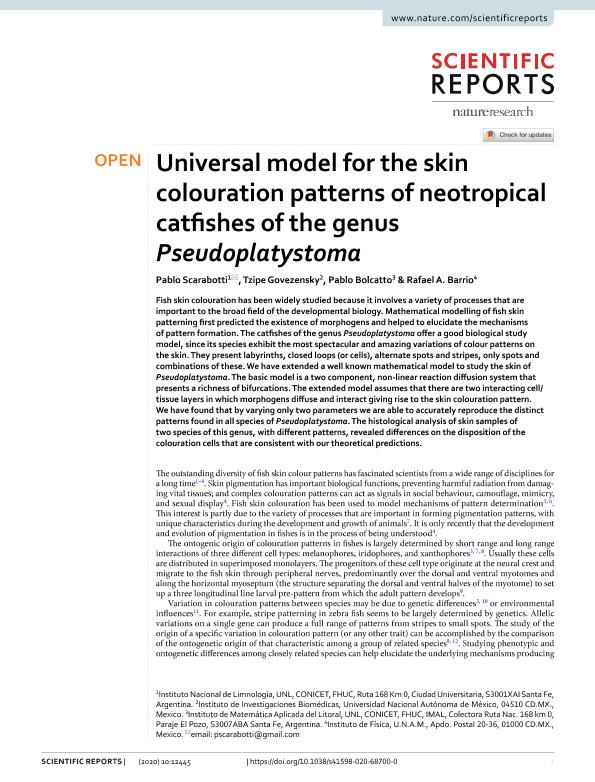Mostrar el registro sencillo del ítem
dc.contributor.author
Scarabotti, Pablo Augusto

dc.contributor.author
Govezensky, Tzipe
dc.contributor.author
Bolcatto, Pablo Guillermo

dc.contributor.author
Barrio, Rafael Ángel

dc.date.available
2021-10-04T19:26:50Z
dc.date.issued
2020-07-24
dc.identifier.citation
Scarabotti, Pablo Augusto; Govezensky, Tzipe; Bolcatto, Pablo Guillermo; Barrio, Rafael Ángel; Universal model for the skin colouration patterns of neotropical catfishes of the genus Pseudoplatystoma; Nature Publishing Group; Scientific Reports; 10; 1; 24-7-2020; 1-11; 12445
dc.identifier.issn
2045-2322
dc.identifier.uri
http://hdl.handle.net/11336/142539
dc.description.abstract
Fish skin colouration has been widely studied because it involves a variety of processes that are important to the broad field of the developmental biology. Mathematical modelling of fish skin patterning first predicted the existence of morphogens and helped to elucidate the mechanisms of pattern formation. The catfishes of the genus Pseudoplatystoma offer a good biological study model, since its species exhibit the most spectacular and amazing variations of colour patterns on the skin. They present labyrinths, closed loops (or cells), alternate spots and stripes, only spots and combinations of these. We have extended a well known mathematical model to study the skin of Pseudoplatystoma. The basic model is a two component, non-linear reaction diffusion system that presents a richness of bifurcations. The extended model assumes that there are two interacting cell/tissue layers in which morphogens diffuse and interact giving rise to the skin colouration pattern. We have found that by varying only two parameters we are able to accurately reproduce the distinct patterns found in all species of Pseudoplatystoma. The histological analysis of skin samples of two species of this genus, with different patterns, revealed differences on the disposition of the colouration cells that are consistent with our theoretical predictions.
dc.format
application/pdf
dc.language.iso
eng
dc.publisher
Nature Publishing Group

dc.rights
info:eu-repo/semantics/openAccess
dc.rights.uri
https://creativecommons.org/licenses/by/2.5/ar/
dc.subject
Morphogenesis
dc.subject
Turing's systems
dc.subject
Fish colouration
dc.subject
Chromatophores
dc.subject.classification
Matemática Aplicada

dc.subject.classification
Matemáticas

dc.subject.classification
CIENCIAS NATURALES Y EXACTAS

dc.title
Universal model for the skin colouration patterns of neotropical catfishes of the genus Pseudoplatystoma
dc.type
info:eu-repo/semantics/article
dc.type
info:ar-repo/semantics/artículo
dc.type
info:eu-repo/semantics/publishedVersion
dc.date.updated
2020-09-25T19:05:54Z
dc.identifier.eissn
2045-2322
dc.journal.volume
10
dc.journal.number
1
dc.journal.pagination
1-11; 12445
dc.journal.pais
Reino Unido

dc.journal.ciudad
Londres
dc.description.fil
Fil: Scarabotti, Pablo Augusto. Consejo Nacional de Investigaciones Científicas y Técnicas. Centro Científico Tecnológico Conicet - Santa Fe. Instituto Nacional de Limnología. Universidad Nacional del Litoral. Instituto Nacional de Limnología; Argentina
dc.description.fil
Fil: Govezensky, Tzipe. Universidad Nacional Autónoma de México; México
dc.description.fil
Fil: Bolcatto, Pablo Guillermo. Consejo Nacional de Investigaciones Científicas y Técnicas. Centro Científico Tecnológico Conicet - Santa Fe. Instituto de Matemática Aplicada del Litoral. Universidad Nacional del Litoral. Instituto de Matemática Aplicada del Litoral; Argentina
dc.description.fil
Fil: Barrio, Rafael Ángel. Universidad Nacional Autónoma de México; México
dc.journal.title
Scientific Reports
dc.relation.alternativeid
info:eu-repo/semantics/altIdentifier/url/http://www.nature.com/articles/s41598-020-68700-0
dc.relation.alternativeid
info:eu-repo/semantics/altIdentifier/doi/http://dx.doi.org/10.1038/s41598-020-68700-0
Archivos asociados
